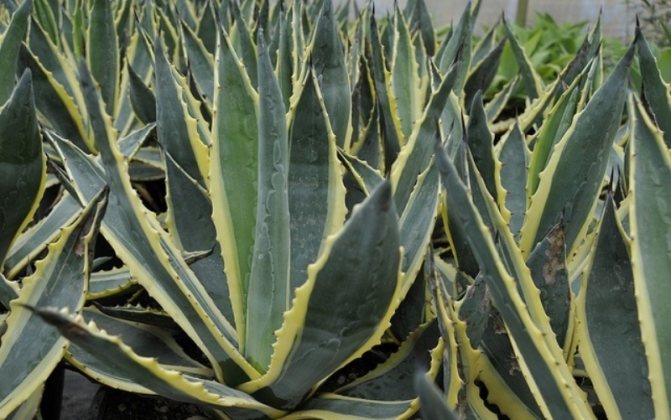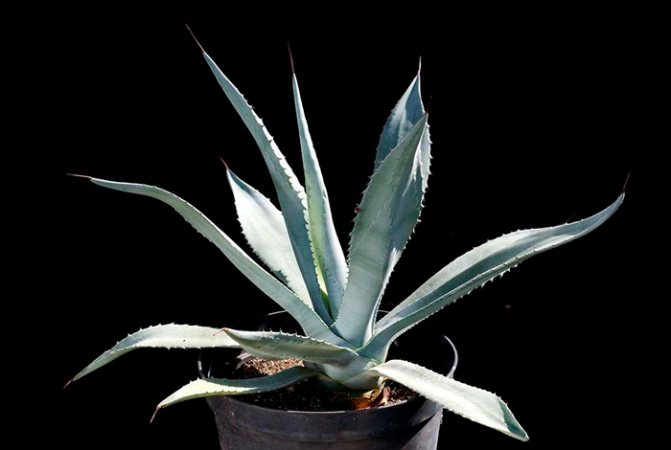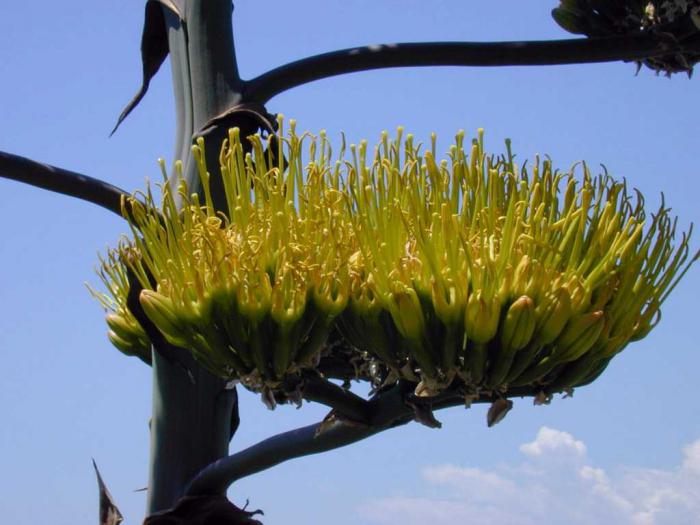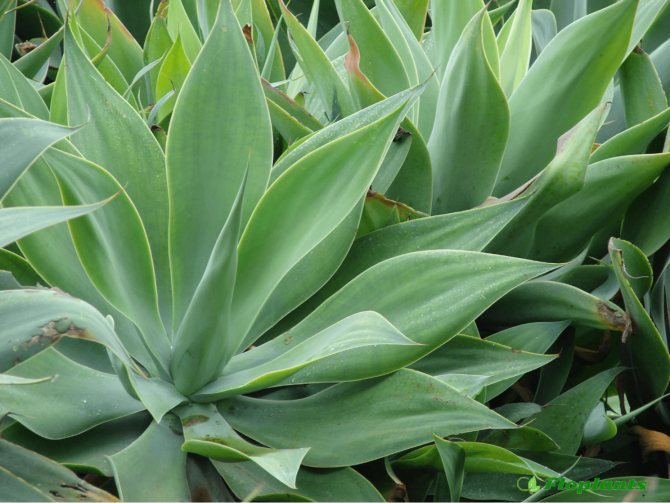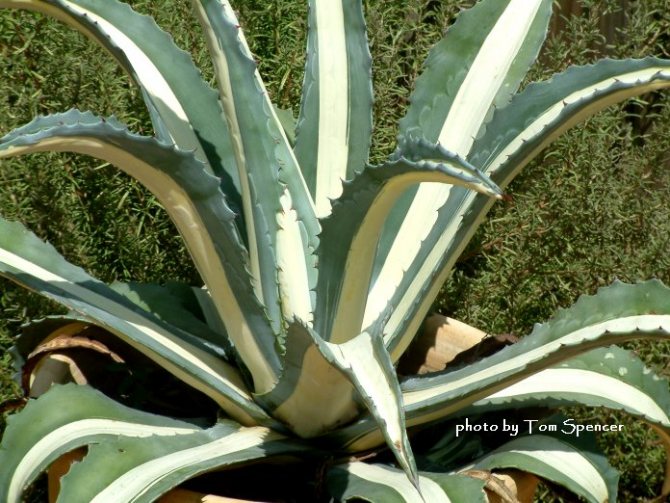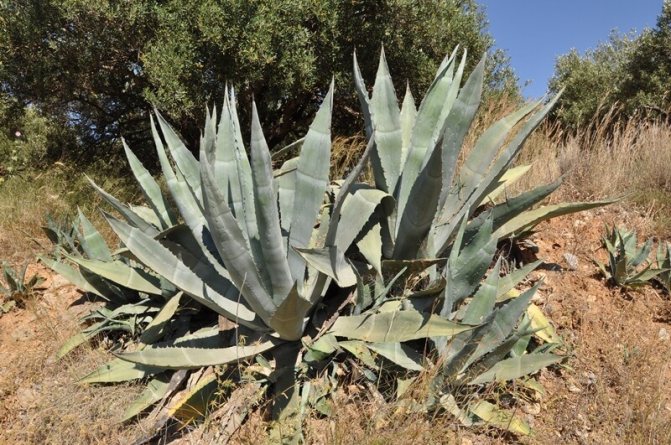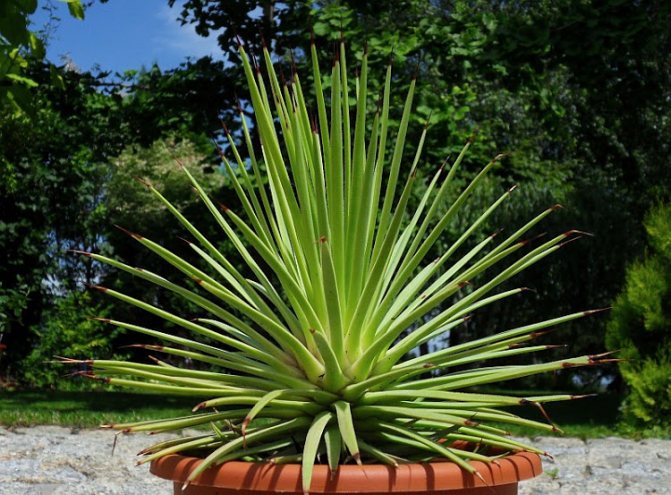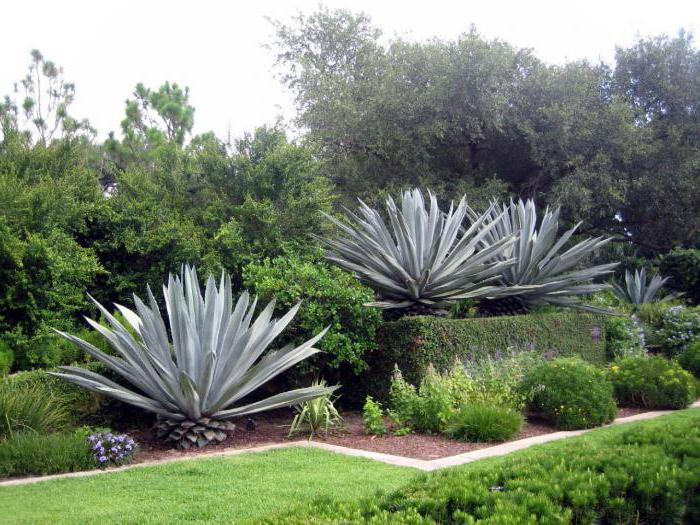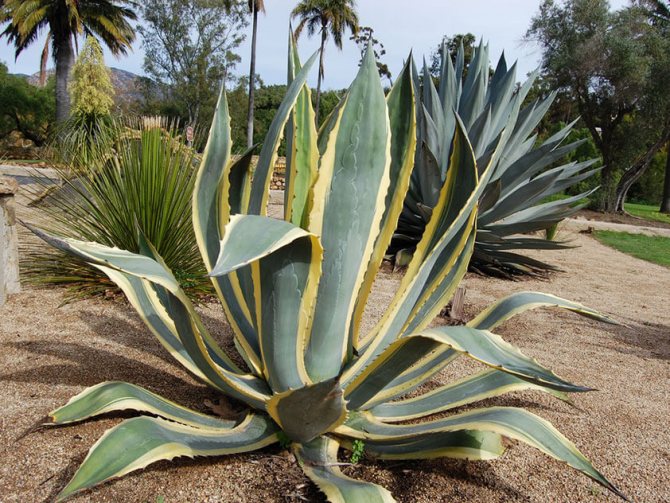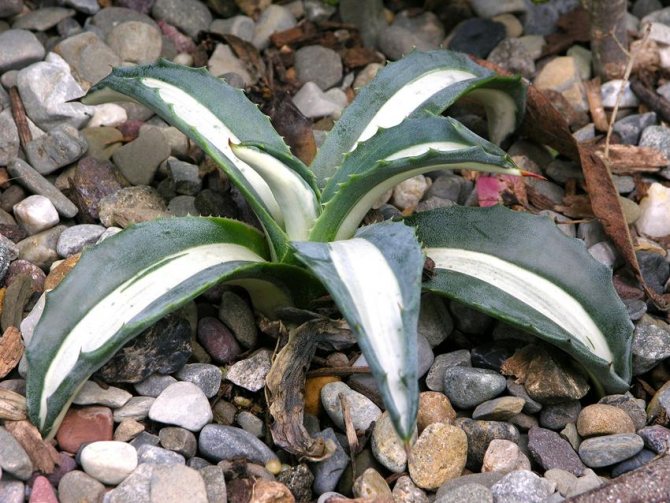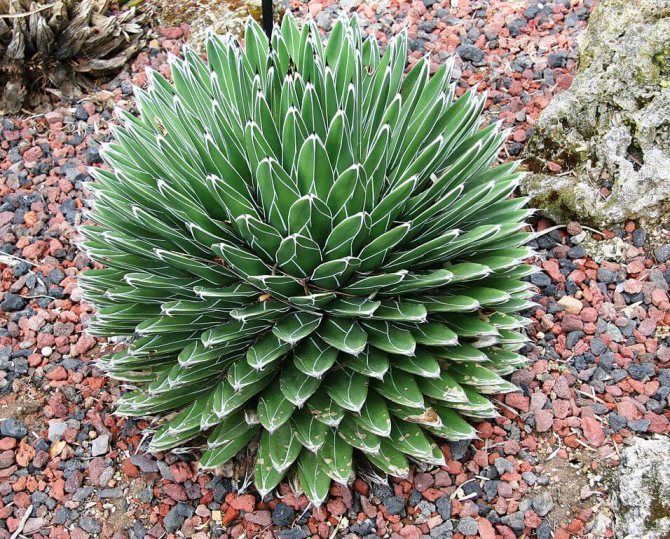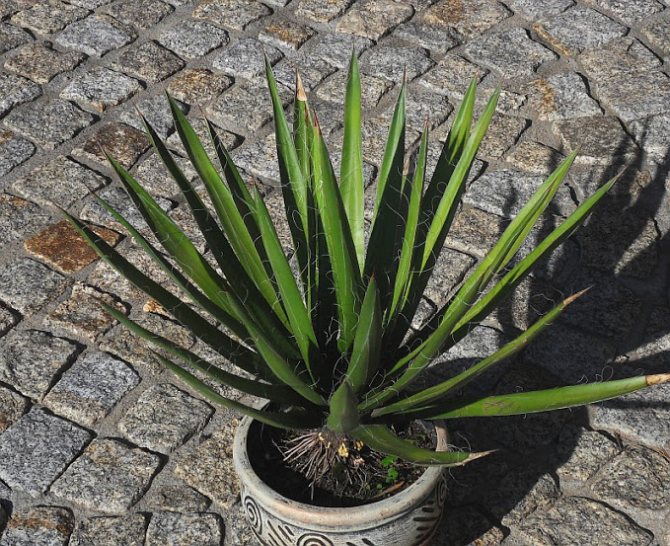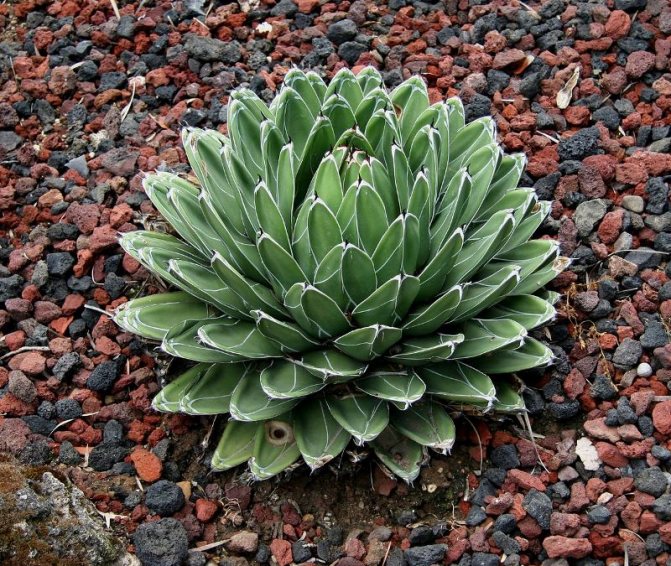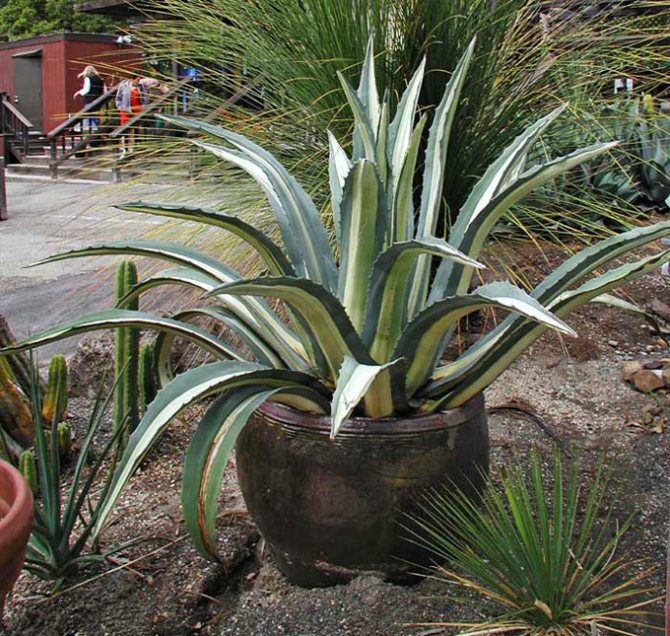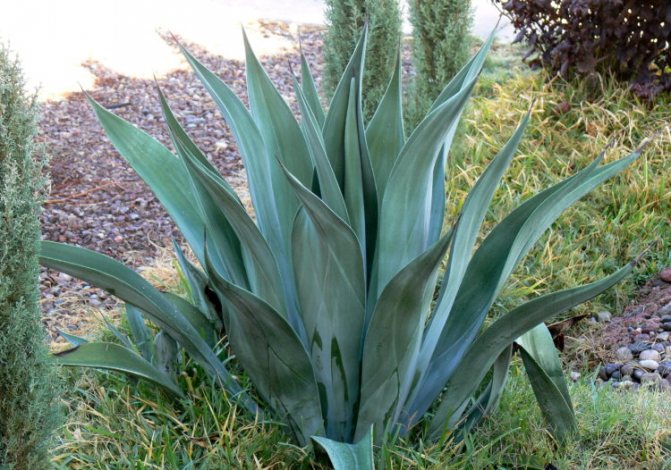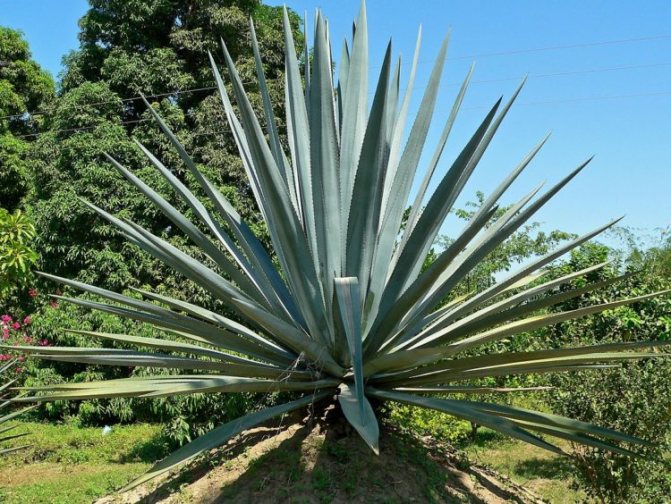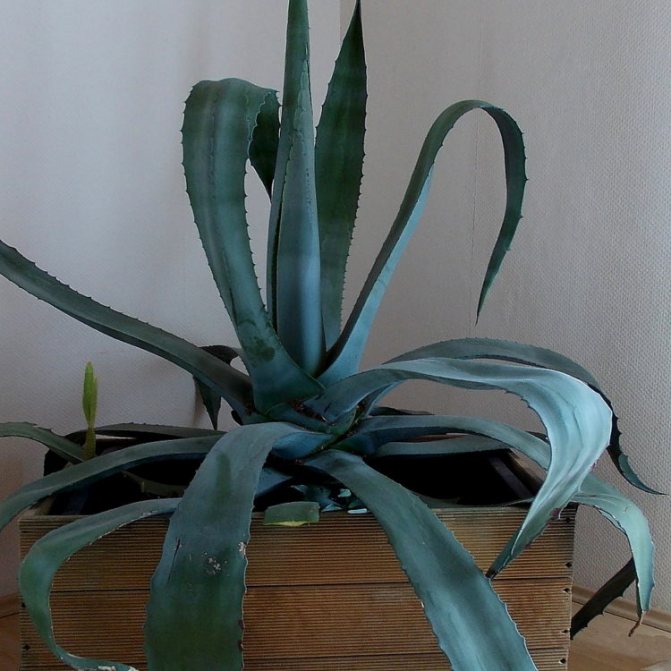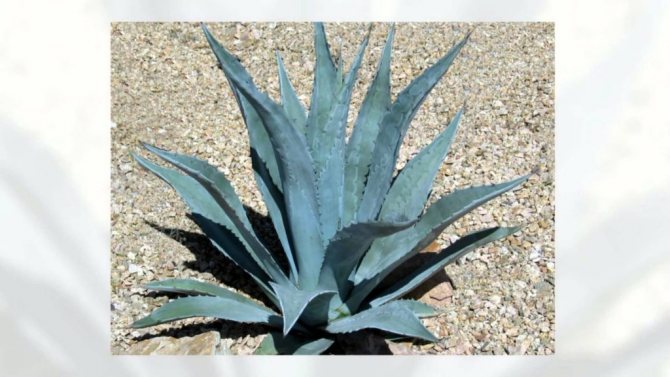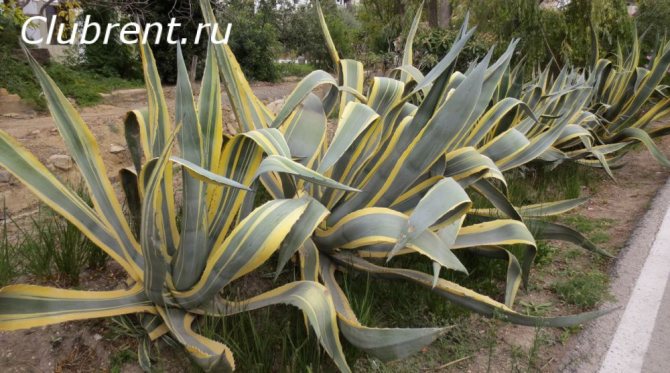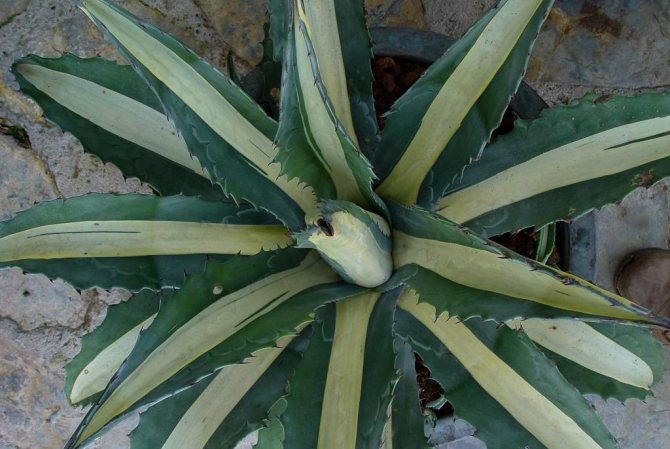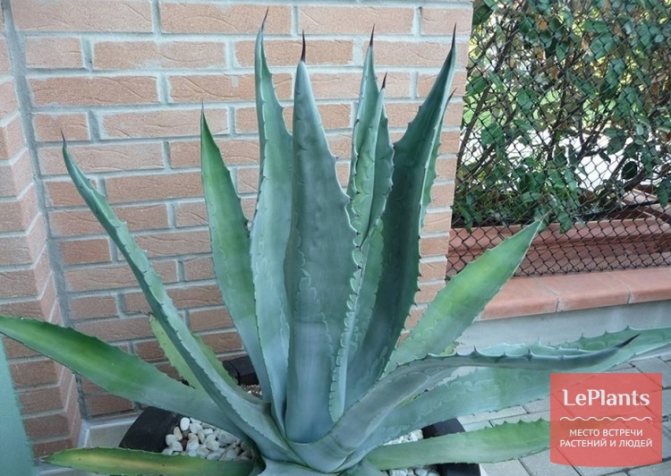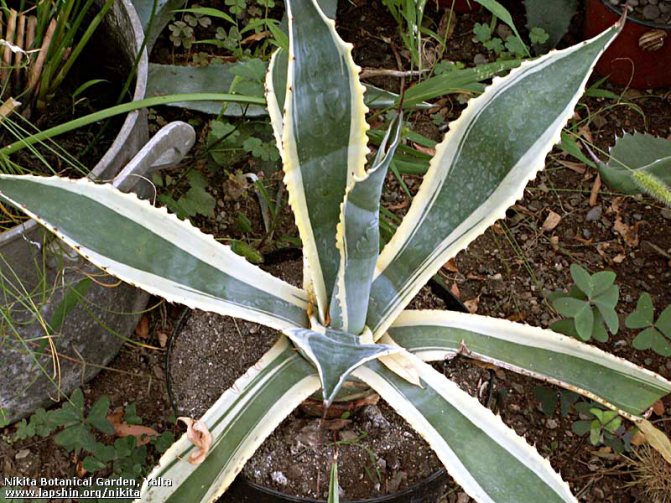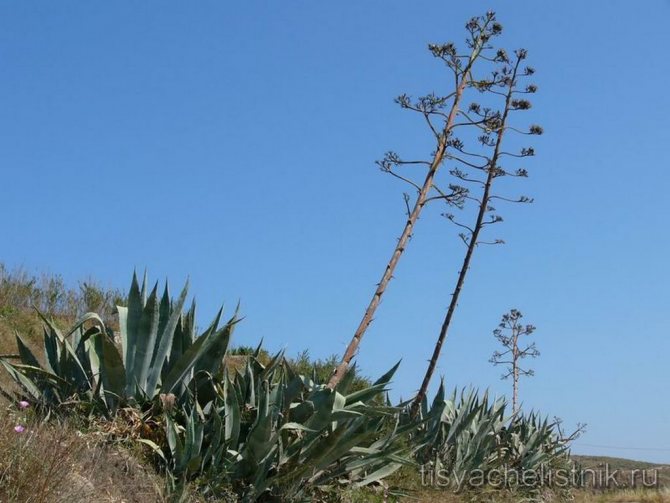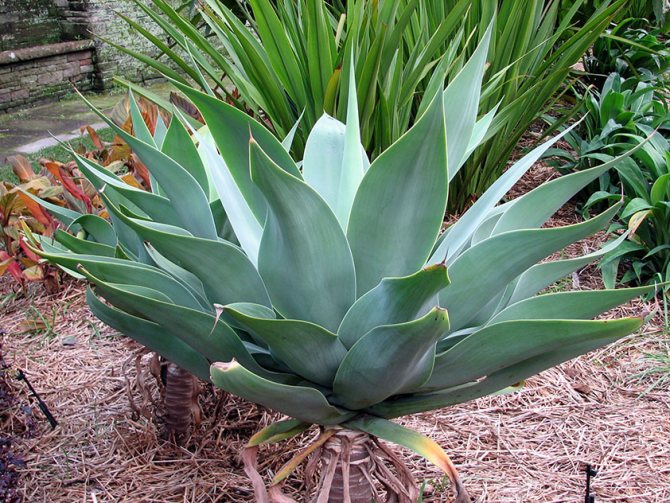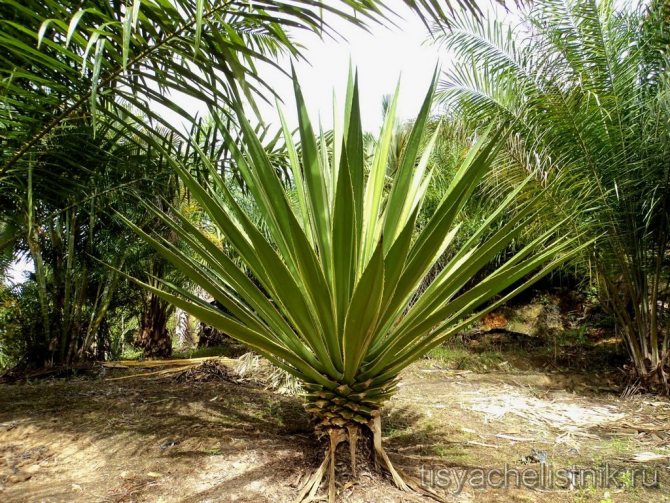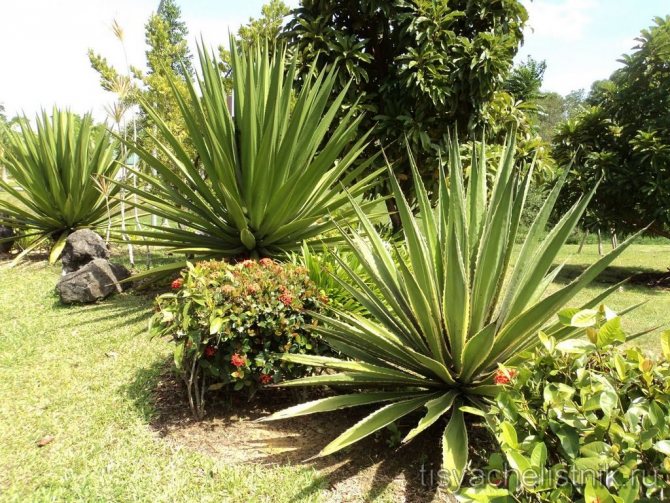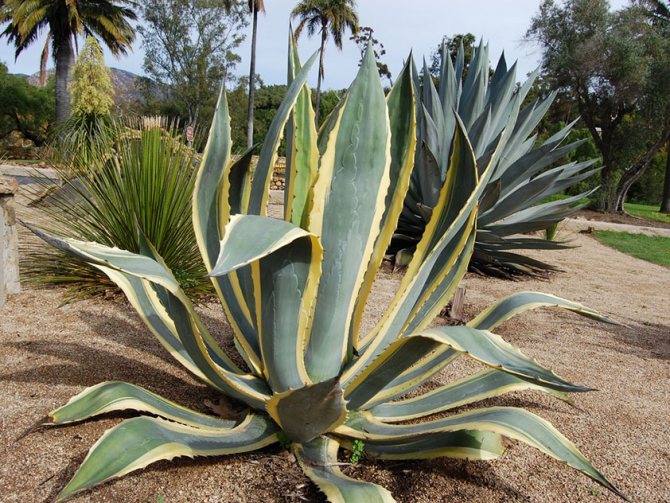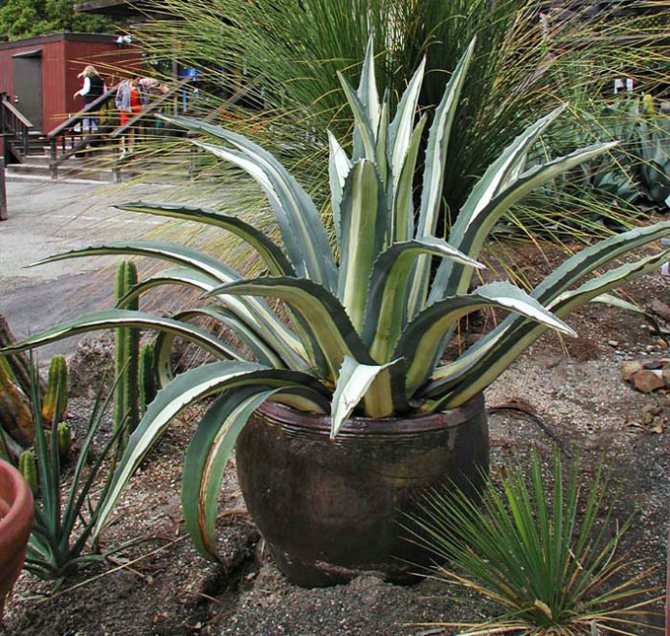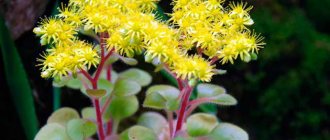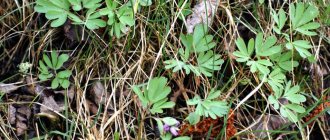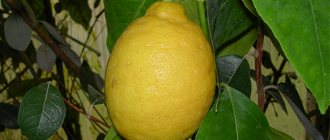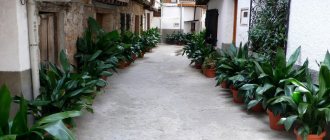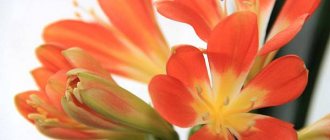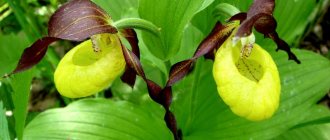Asparagus family. Homeland from South America to the southern states of the United States. Agaves belong to the agave subfamily of the asparagus (asparagus) family (Botanical Journal of the Linnean Society 161 (2): 132-136, 2009) There are more than 200 species in the genus.
Agaves are perennial, very beautiful ornamental plants, but most of the species, due to their large size, are suitable for decorating only flower beds and flower gardens in the southern regions. In indoor conditions, dwarf forms or only young plants are grown.
About the plant
The name agave comes from the Greek "agauos", which translates as "amazing" and "noble". The plant is named after the daughter of one of the most ancient mythical kings. In nature, it blooms quite rarely, at 6-15 years of its life. The peduncle forms an impressive up to 12 m with several thousand flowers.
Agave is a perennial succulent herb with a shortened stem, around which a rosette of hard and fleshy leaves develops. Leaves differ from the leaves of other plants by the presence of water-storing tissue.
Agave leaves are thin, elongated, end at the ends with sharp and hard thorns, therefore, in order to avoid trouble, when grown at home, they should be cut off.
Landing rules
It is impossible to constantly transplant a succulent; during this operation, the roots are damaged, it is difficult for the leaves and the plant to recover. There are three rules for transplanting a flower. Every year in the spring, a young plant is transplanted. An adult flower - as needed, for example, if the pot has become too small. Do not cover the neck of the agave, it should be above the ground. In this position, the plant will feel great. Agave should be replanted when not in bloom.
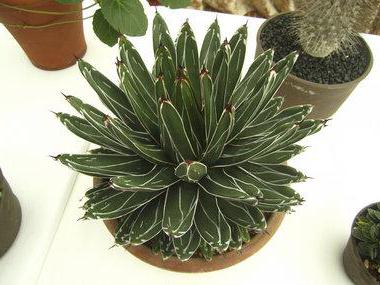
As a last resort, remove the flower, the agave spends most of its energy on its growth. But it is best to wait until the flower fades, and only then start transplanting it.
Agave bloom
At home, agave practically does not bloom, therefore it is sometimes called an agave, mistakenly believing that it blooms after 100 years. In fact, at home and in the open field, agave blooms in the 10-15th year of life, in greenhouses - after 20-30 years. But there are also species that really bloom after 100 years. The flowering of agave is unusually majestic: it grows a long, strong peduncle up to 8 m in height, bearing at the top a huge inflorescence in the shape of a candelabra, numbering several thousand yellowish-white flowers. After flowering, the plant dies off, and young shoots grow from the buds of the rhizomes.
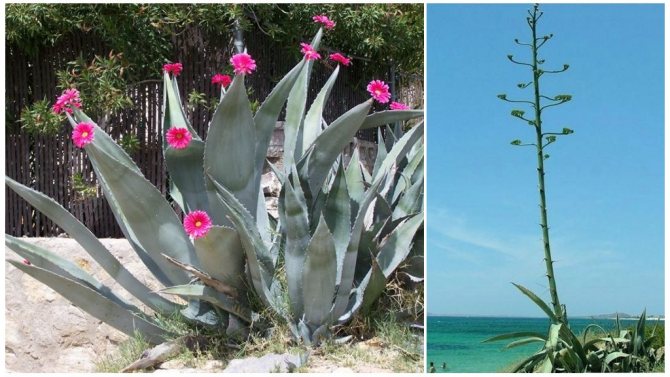

Flowering agave
Community of green men
Agave Agave. Perennial herbaceous rosette succulent plant with a short stem (or without it at all) and forming a basal rosette, fleshy linear leaves, along the edges of which, as a rule, thorns are located. A characteristic feature of agaves is their huge inflorescences. However, they bloom only once in a lifetime, then die.
Etymology
The name comes from agauos, which translated from Greek means "noble", "wonderful", "excellent" and it received it in honor of Agave - the daughter of one of the ancient mythical kings.
Types and varieties of agave
The genus unites about 300 species of leafy succulents, growing from the southern United States to the tropical regions of South America. In culture, about 50 species can be used.
The whole genus is divided into 2 subgenus:
Agava - Plants are distinguished by huge pyramidal inflorescences;
Litea - plants with small rosettes of leaves, and the inflorescences look like spikelets.
It is believed that agave blooms on its 100th anniversary, but this is not the case, blooming in agaves occurs in large species at 30-40 years of age, in miniature ones after a couple of years, after which they all die, leaving behind numerous root suckers. However, in some species, instead of flowers, young plants with roots appear on the inflorescences, which are capable of their own rooting.
American agave, or century-old aloe (Agave americana)
Homeland - Mexico, however, the plant has taken root well throughout the Mediterranean.
A large perennial succulent plant with powerful fleshy succulent leaves, collected in a basal rosette, the diameter of which in adult specimens can reach 3 m.
Leaves are prostrate, curved, blue-green, up to 180 cm long, lanceolate, with an expanded base and apex ending in a thick prickly tip. Along the edges of the leaf, straight or slightly curved strong brown teeth. The top side of the sheet is flat, the bottom is convex.
The inflorescence is a large apical panicle, the height of which can reach 10 meters or more, bearing 10 thousand flowers. Bell-shaped flowers are yellowish, up to 7 cm in diameter. The perianth is funnel-shaped. After flowering and fruiting, the old rosette dies off, and at the base by this time stolon-like shoots are formed, bearing daughter rosettes at the ends.
Cultural forms of American agave:
‘Marginata’ (commercial name: striped agave) - selection form, basal leaves are thick, fleshy green with bright yellow or white edges, non-flowering plants 60–100 cm high;
‘Mediopicta’ (commercial name: variegated agave) - breeding form, leaves with a longitudinal wide central light yellow stripe, non-flowering plants 60–100 cm high;
'Mediopicta Alba' - with a central white stripe.
Queen Victoria's Agave (Agave Victoriae-Reginae)
The species has, in comparison with the previous species, a shallower rosette of a fairly regular spherical shape. The leaves are very hard, lanceolate or narrow triangular, 10–12 cm long and 3–6 cm wide, whole-edged with a short brown-yellow tip at the top along the underside keeled, and soft-triangular in cross-section. There are thin white stripes along the edges of the sheet and along its upper side.
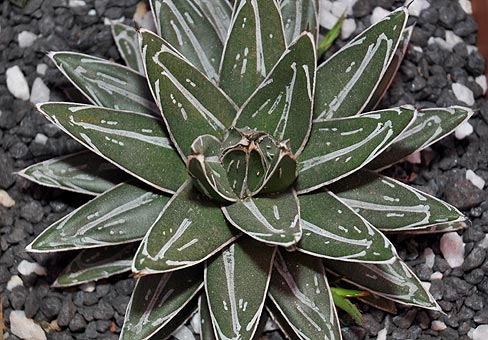

Queen Victoria's Agave (Agave Victoriae-Reginae)
King Ferdinand's Agave (Agava ferdinandi-regis)
A species similar to the previous one, but distinguished by fewer leaves in the rosette and longer thermal spines.
Agave drawn, or agave attenuata (Agave attenuata)
A perennial plant with a stem up to 1.5 m long and a rosette of thin succulent leaves up to 70 cm long, grayish-green with a bluish bloom.
A distinctive feature is completely smooth leaf edges, without thorns.
Agave filifera (Agave filifera)
A very spectacular and interesting look with threads on the leaves - one of the most common in indoor floriculture. Has a spherical dense rosette of leaves, without a pronounced stem. Leaves are long-pointed, green, directed upwards. Gives a lot of root suckers that are easily separated, already with roots.
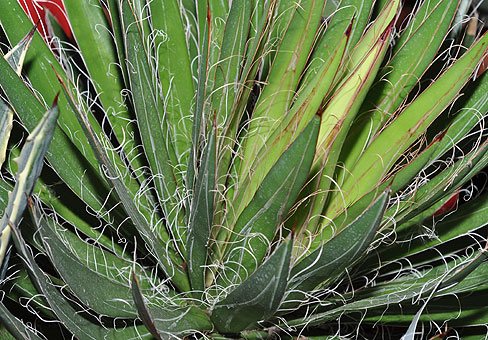

Agave filifera (Agave filifera)
Agave species rare in culture
Agava avellanidens
Quite a large species with a rosette of light-gray leaves with dark spines. The flower stalk is high, the flowers are collected in fluffy inflorescences of a light yellow-green color, several inflorescences bloom at the same time.
Agave drunkards, or agave potatorum (Agava potatorum)
Miniature view with spatulate, jagged light green leaves with a blue irregular bloom, as well as multi-colored thorns (often red). It grows slowly, in culture it retains its compact size for a long time.
Very decorative look.
Agava utahensis
A miniature type of agave, the size of the rosette does not exceed 40 cm in diameter. Leaves are straight, with curved teeth at the edges, decorated with long terminal spines.
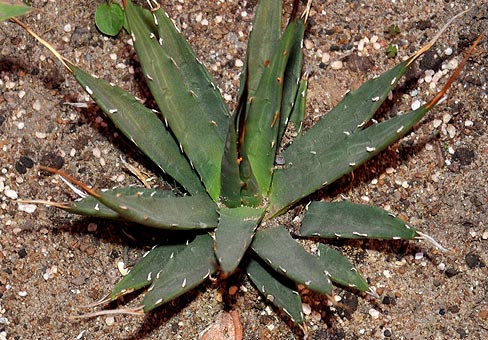

Agava utahensis
Varieties of Yutka agave:
Nevada (var. nevadensis) and elephant-bone-spiny (var. eborispina) - differ in smaller rosettes and long wavy thorns.
Agava tight, miniature form (Agava stricta ‘Nana)
Form with narrow, straight, light yellowish-green leaves.
The species can be propagated by basal offspring.
Dwarf agave (Agava pumila)
A miniature, rare in culture species that retains its juvenile form for 10 years and has a rosette of only 5-8 cm in diameter, consisting of 5-8 short, wide, thick, light green leaves with small denticles at the edges and frequent thin stripes on the outside of the leaf ...
Titanic agave (Agava titanota, Agave sp. FO 0-76)
Miniature appearance with wide, dark green leaves, embossed and light keratinized edging. The thorns along the edges of the leaves are also quite decorative: large, light, curved, the terminal thorn is darker and longer.
Can give root offspring.
Agava guttata
A species with an unusual leopard pattern on relatively narrow leaves.
Moth agave (Agava potatorum)
A large plant with rather wide leaves covered with a silvery waxy coating.


Moth agave (Agava potatorum)
Still in culture, you can grow Schott's agave (Agava schottii), lettuce agave (Agava lechuguilla), or Leopold's agave (Agava leopoldii), prickly agave (Agava xylonacantha), prickly agave (Agava horrida), huge Agava papara
Agave care
It grows well both at home and in cold greenhouses, where the winter temperature at night ranges from +8 to +6 ° C. Needs good lighting and some direct sunlight during the day, prefers the south side. In summer, it is good to put it out on the street. In spring and summer, plants do not need shading.
Agaves are watered moderately in winter, plentifully in summer, letting the potting mix dry in the container between waterings. Does not need spraying. From spring to autumn, fertilizing with fertilizers for cacti is required once every 2 weeks. The transplant is carried out in 3-4 years by the transshipment method. Agave is unpretentious, but grows better in spacious pots, large specimens do well in wooden tubs. When planting, it is necessary to ensure that the neck of the plant is slightly above the soil level. The drainage material is filled approximately 1/4 of the container height. A soil mixture is used: sod land, leaf land, sand (1: 1: 1).
Be extremely careful when working with agaves, as they usually have very sharp thorns at the ends of their leaves. Species such as striped agave and straight agave are generally not recommended for growing in homes with children and pets.
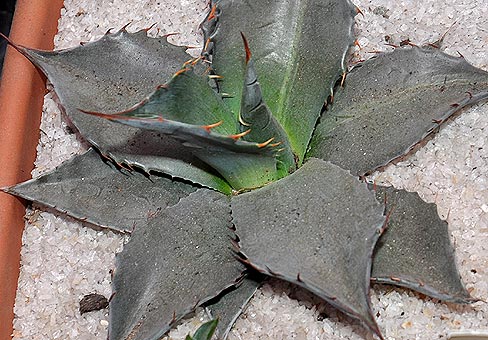

Agava aff. parasana
Possible problems when growing agave:
- brown plaques on the surface of leaves and stems of agave - scale insects (these pests suck out cell sap, the leaves lose their color, dry and fall off). For mechanical cleaning of pests, the leaves are wiped with a soapy sponge, then the plant is sprayed with 0.15% actellic solution (1-2 ml per liter of water);
- yellowing of agave leaves - lack of macronutrients, overdrying of plants (in summer), or lack of light, high air temperature, especially at night (in autumn and winter);
- yellowing of the ends of leaves in agave - excess calcium in the soil, dryness of the earthen coma;
- the appearance of a cobweb on a plant — a spider mite, which appears when the air is too dry - a cobweb appears in the internodes on the stems, the leaves become lethargic and fall off. The plant is wiped with a soapy sponge and washed under a warm shower, regularly sprayed;
- loss of turgor, sagging leaves, shedding of green leaves - insufficient watering, inconsistency in temperature conditions, especially in winter;
- the appearance of wrinkles on agave leaves - a sudden effect of cold, or, in old leaves, a lack of magnesium, potassium, phosphorus;
- yellowing of the whole agave plant - severe dryness or excessive soil moisture, dry air, too heavy earth or density of an earthen coma, its airtightness, possibly preparing the plant for dormancy.
Agave propagation
At home, agave can be propagated in several ways: by offspring, cuttings of rhizomes, seeds. When separating the offspring formed at the base of the trunk, the cut must be wilted. They are transplanted into separate pots, into a slightly moistened soil mixture, watering is started after 2-3 days. Until fully rooted, watered carefully, in a thin stream, so as not to erode the soil around the plant. Cuttings of rhizomes are cut so that each has at least one bud, must be left to dry for 2-3 hours, sprinkled with crushed charcoal, then planted in a pot of sand for rooting and watered with water at room temperature. In the first year of vegetation, young agaves form 4–6 leaves, in the second - 7–9, in the third - 10–12 leaves. Seed propagation takes a long time.
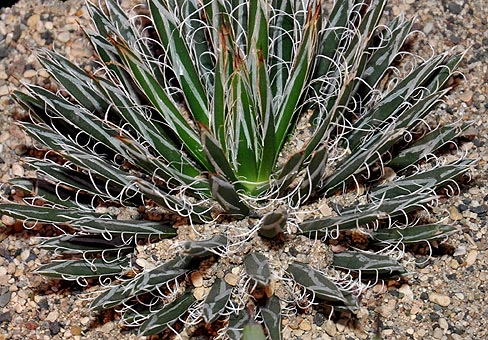

Agava parviflora
Phytodesigner's advice
We use agave as a deciduous ornamental plant for flower decoration of gardens and parks, flower beds, for landscaping large rooms, winter gardens; less common in indoor culture. Large specimens of agave look spectacular in open ground flower beds in combination with bright summer gardens. As a pot plant, species that are small in size and slow in growth can be used. Agave is unpretentious, it can grow both on the windowsill and in other sufficiently lit places.
Interesting facts about agave
In Mexico, the agave is so widespread that the country got its name in her honor - “the place of the agave”.
Agave does not bloom in rooms, therefore it is often called an agave, mistakenly believing that it blooms after 100 years. In fact, in its homeland in the open field, American Agave blooms in the 10-15th year of life, in greenhouses - after 20-30 years. But there are also species that really bloom after 100 years. The flowering of American Agave is unusually majestic: it grows a long, strong peduncle up to 10 m high, bearing at the top a huge inflorescence in the shape of a candelabra, numbering several thousand yellowish-white flowers. After flowering and ripening of seeds, bulbs appear in this inflorescence, which eventually develop into tiny agaves with leaves and roots. These babies fall to the ground, where they take root and soon turn into adult agaves.
Leaves of many types of agave are used to make ropes, cords, rugs, packing and other rough fabrics; paper is produced from waste. The Indians used the filamentous agave fiber as thread for sewing, and with a finished needle at the end - its role was played by a sharp thorn crowning the agave leaf.
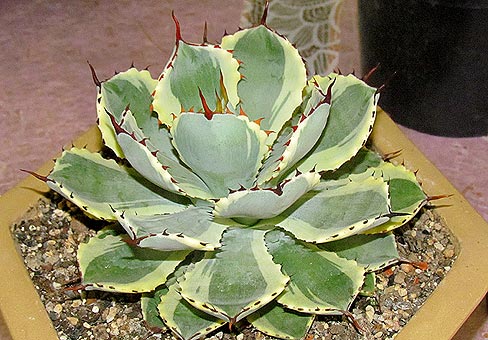

Agava 'Kissho Kan'
The famous beer is made from the juice contained in a huge stalk of agave “Pulgue«.
The Aztecs made a product from agave that made agave especially popular in its time - its sweet juice. Get it at the moment when the plant is about to bloom. The bud, from which the flower arrow was supposed to develop, is cut out, leaving a hole in its place, in which the juice, containing about 10% sugar, accumulates.Up to 5–7 liters can be harvested from each plant per day, despite the fact that the juicing period is about three months. The Aztecs mined sugar from agave juice, boiled molasses, but mostly fermented, obtaining a drink containing 4–8% alcohol - pulque. Later, the Spaniards who arrived in Mexico shared the love for pulca, so that the collection of agave juice did not stop with the disappearance of the Aztec civilization. The Spaniards, on the other hand, made an improvement in the use of pulque - distillation. A new, much stronger, agave drink is called "tequila" - now you can buy it in our stores.
Home ecology
Volatile plant secretions (phytoncides) have a disinfecting effect and increase the defenses of the human body, reduce the amount of harmful microflora in enclosed spaces, enrich the environment with organic and mineral substances, and increase the amount of negative air ions, which contributes to its purification. The composition of the air under the influence of volatile secretions of agave approaches that of the forest, in addition, in the room where the agave is located, the number of harmful insects is sharply reduced.
Agave energy
Agave has a very powerful energy. According to some experts, this plant should not be kept in the house at all, as people inevitably fall under its influence. However, in many cultures, agave is considered the key to family happiness and peace in the home. It has a beneficial effect on the relationships of household members, preventing quarrels and conflicts. In any case, this plant should not be placed in the bedroom or nursery. The ideal location is a winter garden or a greenhouse, but many find a place for agave in the living room.
The healing properties of agave
The chemical composition of agave is poorly understood, but in folk medicine its leaves are used as a disinfectant, analgesic, anti-inflammatory, antipyretic and expectorant. For medicinal purposes, you should use the leaves of plants that are at least three years old. The most common use of American Agave leaves in the treatment of sciatica, sciatica. The treatment is carried out by rubbing in a pulp from a sheet grated on a frequent grater overnight. It should be remembered that agave should be taken orally in a diluted state, in small doses or in boiled form, so as not to get severe burns of the mucous membrane of the gastrointestinal tract.
The most famous and used in medicine are two types of agave - American agave and Sisal agave (Agave sisalana). The leaves of both types contain steroidal saponins, which are used to synthesize steroid hormonal drugs. In China, from both types of agave, substances have been obtained that make up a new group of contraceptives.
Agave transplant
Young plants require an annual spring transplant. An adult agave is transplanted every 3-4 years. Note that when planting, the neck of the plant should not be deepened too much, in this position it quickly begins to rot, which leads to its death.
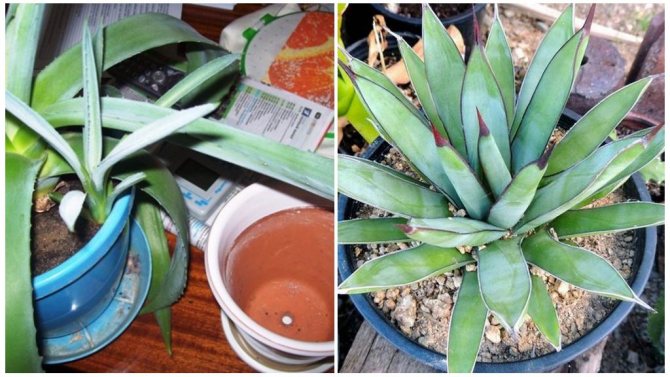

Agave transplant
On a note!!!
When transplanting, you should choose a pot that is slightly larger than the previous one. The plant is grown in flat containers.
How to care for agave at home
Agave care rules are not particularly difficult. Like all succulents, the plant is unpretentious and able to survive some difficulties. But still, starting this exotic flower, one should provide favorable conditions for it for rapid development and a beautiful decorative appearance.
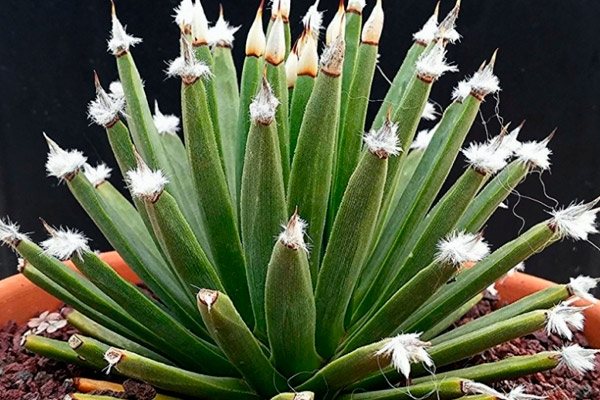

How to care for agave at home
Place and lighting for placing agave
Agave is very light-requiring. She especially needs a lot of lighting in the first years of her life. The plant tolerates sunlight well. Flower pots can be placed on south windows. If the summer in the region is hot, then it is advisable to shade the plant at midday. From the scorching sun pouring young sockets can suffer.
In the shade, the bush will develop very poorly and its leaves will most likely be pale.In winter, it is recommended to create additional lighting for the outlets so that the daylight hours for the succulent are at least 10 hours.
Temperature
A guest of the desert prairies cannot stand the cold. The optimum temperature for growing agave in summer is + 22-30ºC. The flower can easily withstand hotter climates, provided regular watering.
In winter, the temperature of the content can be reduced to + 15-18ºC. In the summer, it is useful to take flowerpots outside and place them in lighted areas. But keep in mind that agave does not like drafts. The critical temperature for sockets is + 8-10ºC. The roots begin to freeze and may die.
Humidity
Succulent is insensitive to air humidity. Growing an agave at home, you do not have to worry about this indicator - the usual microclimate of a residential apartment is quite suitable for the life and development of a flower.
You should not place pots near heating devices, excessive dry air is not good for the succulent. In the summer, even in the hottest weather, you do not need to spray the sockets.
On a note! Many medicinal products are produced from agave juice, and it is also used in the food industry. But for this, only some types of plants are used. Among the varieties there are also poisonous specimens, so you should not experiment with the juice yourself.
Watering
Water the agave sparingly. In the warm season, the substrate is moistened when the top layer dries out by about 80%. From autumn to spring, watering is reduced and the soil is irrigated only when its top layer dries out completely.
Do not allow stagnation of water in the pot and pan. Waterlogging of the substrate is detrimental to the flower.
It is recommended to use purified water (filtered, separated), and always at room temperature. If possible, it will be useful to water the succulent with melt, rain or river water.
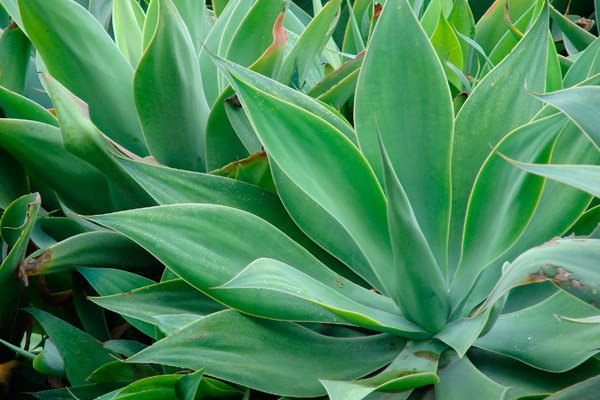

How to water an agave
Top dressing
It is possible and even necessary to feed agave. Fertilizers should be chosen complex mineral for succulents and cacti.
Top dressing begins to be applied to the soil in the spring, with a frequency of 2 times a month. At the end of summer, fertilization is reduced to 1 time per month, and closer to winter, it is completely excluded.
Transplant, soil selection
Agave grows quickly and until it reaches its maximum growth, it is advisable to replant it every year. The rosettes are actively developing in width, so the pots should be selected not very high, but wide.
When the bush turns 5 years old, you can transplant it 1 time in 3-4 years.
The "exotic guest" needs a neutral, light soil with good drainage properties.
The store sells ready-made soil mixtures for cacti and succulents, they are ideal for agave.
If you prepare the soil yourself, you need to mix the following components in equal parts:
- The land is soddy.
- The land is leafy.
- Sand.
Drainage material must be laid at the bottom of the flowerpot: expanded clay, brick chips, polystyrene, crushed stone or just small pebbles. It is recommended to add some charcoal to the substrate. The transplant is done in the spring.
Reproduction of succulent
Agave practically does not bloom at home. It will be extremely difficult to get seeds from her. Seedlings sold in stores have a very low germination rate.
The easiest way to propagate agave yourself is by cuttings. A leaf is separated from the outlet, the cut is treated with charcoal or activated carbon, and allowed to dry a little (1 day). Then the cutting is deepened into a nutrient mixture of sand and peat. After about a month, the shoot should take root, after which it can be transplanted into normal soil.
If the rosette has grown well in breadth, you can separate a part from it along with the rhizome for reproduction and immediately transplant it into a full-fledged soil mixture.
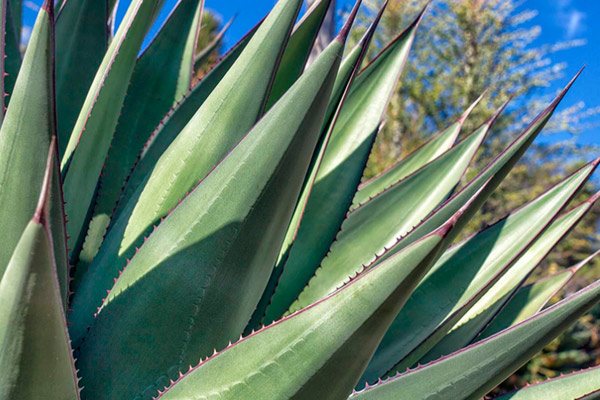

Reproduction of succulent
Diseases, pests of agave
Agave has very dense leaves, so insects that feed on plant sap hardly affect it.Mealybugs can grow in the soil, they live in the roots and feed on their juice.
With high humidity and excessive watering in the outlet, a fungal infection (black or gray rot) can start. In flower shops, drugs are sold for any pests and fungal diseases. It is necessary to process the plant as soon as possible in order to save it.
With improper care, the succulent also exhibits painful symptoms:
- Leaves wrinkle, become lethargic - most likely, an excess of moisture.
- The tips of the leaves have begun to turn yellow - perhaps too much calcium gets into the soil or the air is too dry.
- Leaves dry out, lose their fleshiness - there is little moisture, watering should be increased.
- Brown spots have appeared on the leaves - it looks like the bush is getting more sun than it needs.
- The rosette grows very slowly - lack of lighting.
Now you are more familiar with the agave plant, home care for which will not scare off even beginners in floriculture. The culture is not for everybody, and is unlikely to suit those who like lush flowering indoor plants. But for those who appreciate the peculiar beauty and grace of succulents, agave will be an excellent green friend.
Agave reproduction
Propagated by seeds and daughter processes that form at the base of the mother plant.
Agave from seeds
Seeds are sown in February-March to a depth of 0.5-1 cm. At a temperature of 20-25 °, seeds germinate within 5-7 days.
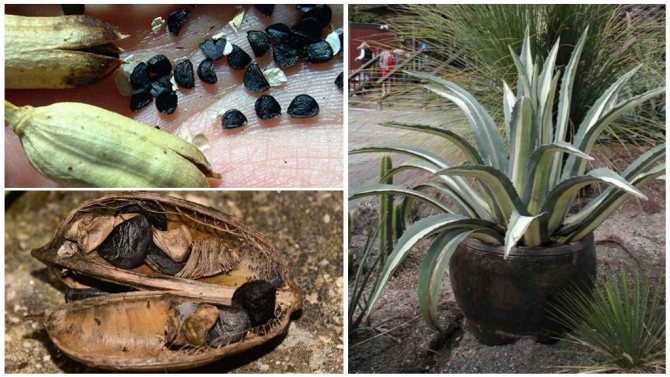

Agave seeds
15-20 days after the appearance of the first leaf, the second develops, after 20 days - the third leaf, which in two weeks reaches 8 cm long and 1.5 cm wide.
By this time, the third adventitious root appears. After 2-3 weeks, the fourth leaf is shown and a rosette is formed. The shortened underground stem reaches 1-1.5 cm in diameter.
Agave propagation by shoots
Agaves are propagated by shoots that form at the base of the trunk. By separating them from the mother trunk or by segments of rhizomes from a shortened trunk, the plant is propagated. There should be one knot on each separated piece. The cut pieces are dried (2-3 hours), and then sprinkled with charcoal powder and planted in sand at a temperature of 20 °.
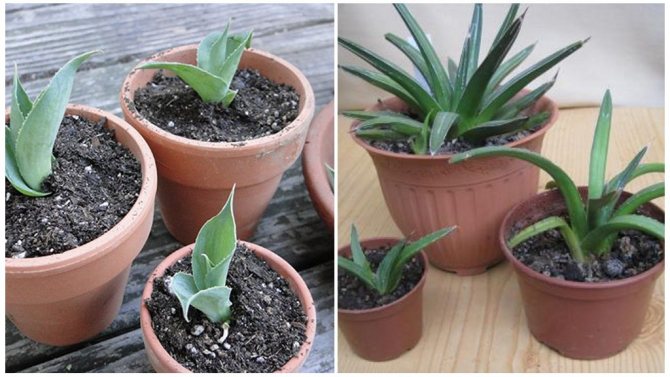

Agave propagation by shoots
The separated offspring are planted in pots. The composition of the earthen mixture is as follows: turf, leaf, sand (1: 1: 1 h). After planting, the plants begin to water in 2-3 days.
In the summer, it is advisable to take young plants into a greenhouse. In the first year of vegetation, young agaves form 4-6 leaves, in the second - 7-9, in the third - 10-12 leaves.
Using the medicinal properties of agave
The complete chemical composition of a plant at different ages and under different growing conditions has not been studied. For the treatment of various diseases, the juice and pulp of agave leaves are used not younger than 3 years of age.
The medicinal properties of succulent are used for:
- Almost all gastrointestinal problems, to improve the functioning of the digestive tract.
- Respiratory diseases.
- Skin diseases.
- Problems in the genitourinary system.
- Frostbite, edema, burns.
- Being overweight as a cleansing agent.
The main contraindications are pregnancy, baby feeding, allergic reactions. Official medicine on an industrial scale from the leaves of the succulent receives a hormonal contraceptive.
Agave is quite unpretentious, rarely gets sick, and practically does not need watering. With the right choice, it will become a worthy decoration for your home collection of plants or will be useful in the treatment of various diseases.
Agave: diseases and pests
The agave plant can be affected by the scabbard. To combat this pest, the leaves of the plant should be washed with a solution of soapy water or boric acid. The procedure is repeated every 4-5 days, until the complete disappearance of the pest. You can buy a special drug in the store to combat the scabbard.
If the lower leaves of the plant turn yellow, the amount and abundance of watering should be reduced. Stagnation of water in the sump is also contraindicated, so good drainage is needed.
The lower leaves of some agaves naturally die off.
The leaves stretch out and turn pale, the rosette becomes ugly, mainly from a lack of light.
Growing problems
Most often, agaves suffer from a lack of light in winter - while the leaves become smaller, the plant stretches. In a properly grown plant, the leaves sit on the stem pressed tightly against each other. With a lack of lighting, the stem is pulled out and the leaves appear at a certain distance from each other, this spoils the plant.
Stem and root rot - agave often suffer, at low temperatures and high soil moisture. If agaves are kept cool in winter, then watering is very rare. In summer, decay can begin if there is no drainage in the pot and, moreover, there is no drainage hole, and watering is plentiful. With an excess of watering, the leaves become soft, pale and droop, at this moment the roots begin to rot. Agaves will more easily tolerate a lack of moisture, like all succulent plants, than excess moisture.
The benefits of agave
Agave is not only an interesting flower, but also very useful. Helps to cure diseases of bones and joints.
A tincture of American agave leaves is used to treat rheumatism. Prepare it as follows. Crushed leaves are poured with 40-70% alcohol or vodka at the rate of 1:10. The mixture is tightly closed and kept at room temperature for 7 days. Then it is filtered and poured into a dark bottle. Used for rubbing with rheumatism, to induce a rush of blood to the affected area.
On a note!!!
Before using the tincture, it is worth checking if there is an allergic reaction to this remedy. First, you should anoint a small area of the skin, if redness does not appear, then the product can be safely applied.
Air humidity
Agave does not need to be sprayed. It is also not recommended to put a container of water or a humidifier next to the flower.
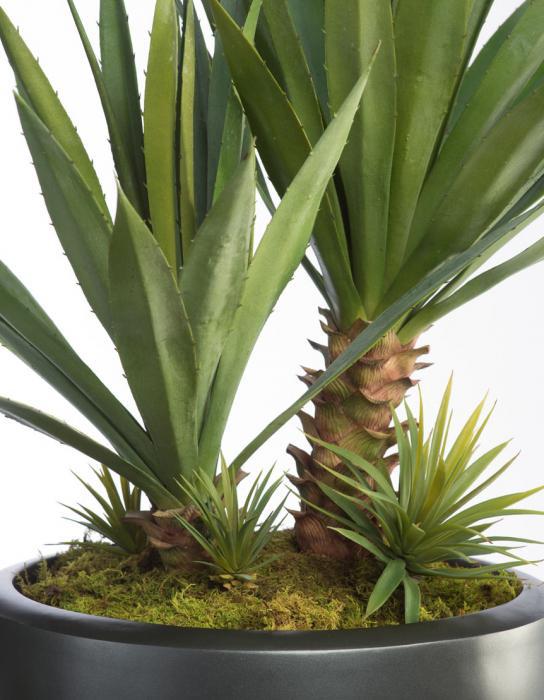

As a rule, apartments have dry air suitable for the plant. If the sockets of the plant are dusty, then they can be wiped with a damp cloth. After this procedure, do not forget to dry them, otherwise rotting and leaves will occur.
Agave species
Agave is a unique plant. It has many types and subspecies, each of which is very interesting. Below are the most popular agave varieties.
American agave (Agave americana)
One type of agave grown in rooms. The plant has a shortened stem and a rosette of large basal leaves. Leaves are gray-green, thick, hard, linear-lanceolate, tapering towards the apex, concave above, convex below. The edges of the leaves are with sharp thorns, the top ends with a hard sharp thorn. There are forms with yellowish or white longitudinal stripes on the leaves.
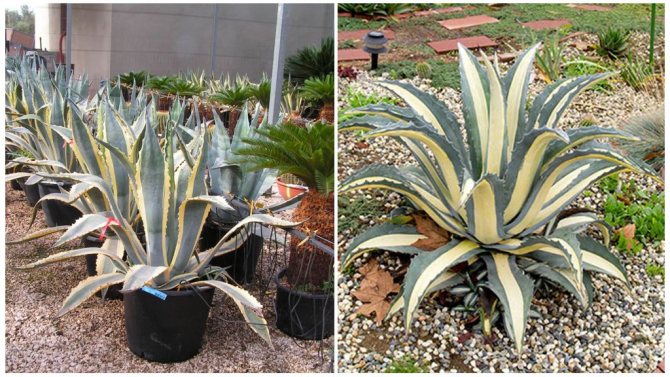

American agave (Agave americana)
Agave filifera (Agave filifera)
Homeland - Mexico (Pachuca). The rosette is stemless, spherical. Leaves are lanceolate, numerous, long-pointed, dull-shiny, green with white lines along the edges. Peduncle up to 250 cm high. The inflorescence is a very dense ear. Filamentous agave grows slowly. White threads are separated from its leaves, which makes the plant very decorative and can be used in compositions in bright, spacious rooms.
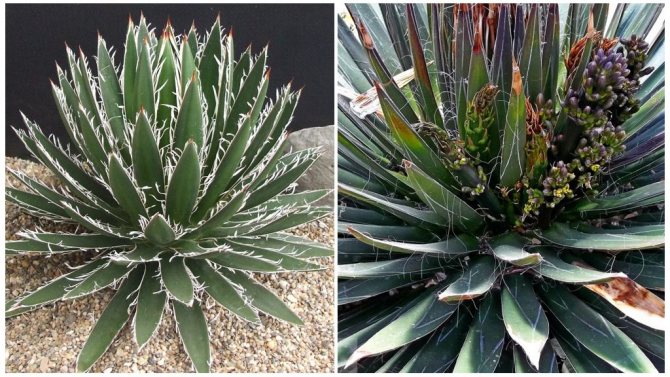

Agave filifera (Agave filifera)
Agave stricta Solm
Homeland - Mexico (Pueb-la). With age, the plant branches, becomes multi-rosette, individual rosettes are very dense, spherical and multi-leaved. Leaves are succulent, erect or slightly curved, widened at the base and sharply become linear, the ends are short-pointed, green. Peduncle up to 225 cm long. A very decorative look that will adorn any exhibition.
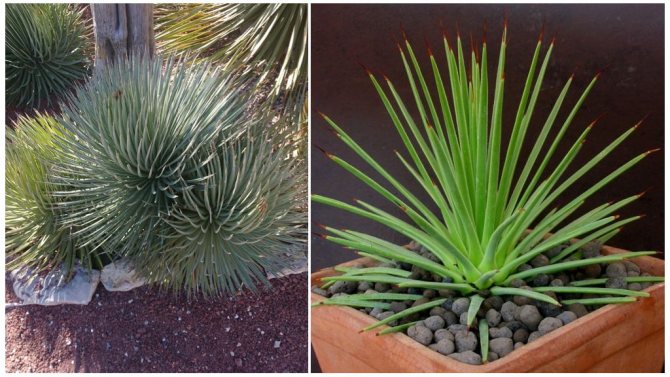

Agave stricta Solm
Agave striped (Agave striata Zucc)
Leaves are linear, 40-70 cm long and 0.7 cm wide, grayish-green, with dark stripes, with a middle vein protruding from both sides, dense, erect; apical spine brown, 0.6-0.8 cm long.It grows among xerophytic shrubs at an altitude of 2000-2200 m above sea level in Mexico. Due to their size and sharp thorns on the leaves, they are of little use for a small room.
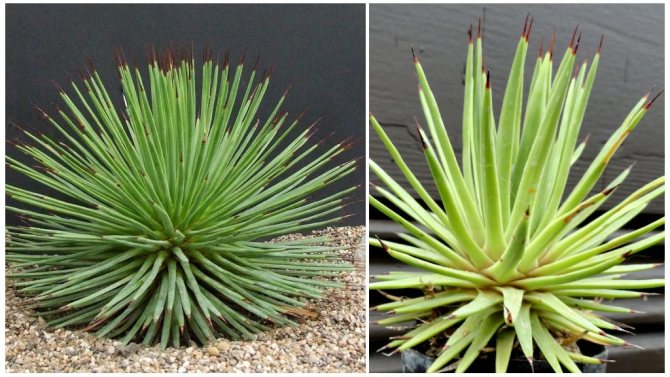

Agave striped (Agave striata Zucc)
Agave Salm-Dyck (Agave attenuata Salm-Dyck)
A powerful plant with a stem reaching 1.5 meters in height and 8-15 cm in diameter, erect or slightly drooping, topped with a rosette of 20-25 fleshy leaves. Leaves 50-70 cm long and 12-16 cm wide.
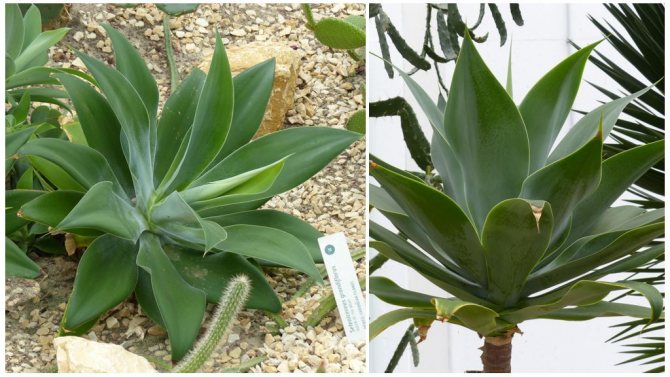

Agave Salm-Dyck (Agave attenuata Salm-Dyck)
Queen Victoria's Agave (Agave victoriae reginae T. Moore)
A very beautiful view, recommended for indoor cultivation, the rosette of leaves reaches 60 cm in diameter. Leaves 10-15 cm long, 5-7 cm wide, dark green, with white, oblique lines on both sides; on the reverse side there is a keel, on which, as well as along the edges, the corneous line runs. The end of the leaf has one black spine (1-2 cm long) and one or two shorter ones.
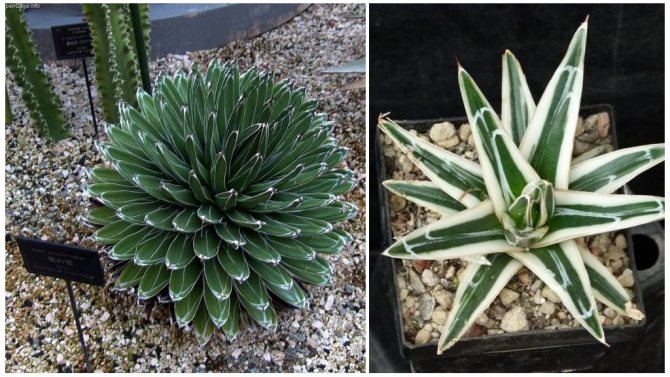

Queen Victoria's Agave (Agave victoriae reginae T. Moore)
Agave toumeyana Trel
A perennial herb that forms turf. Rosette of leaves 30-80 cm in diameter. Leaves are lanceolate, leathery, 15 to 25 cm long and 10-25 cm wide, light green with white stripes and separating white filaments along the edges; the tip of a leaf with a thorn 5-8 mm in length. A species close to filamentous agave. Homeland - USA (Central Arizona).


Agave toumeyana Trel
Agave parrasana Berger
Rosette of leaves up to 60 cm in diameter. Leaves obovate, about 30 cm long, 10-16 cm wide, dull green with a bluish-gray waxy bloom; the upper side is strongly concave; leaf edges and end with red-brown spines up to 17-20 mm in length.
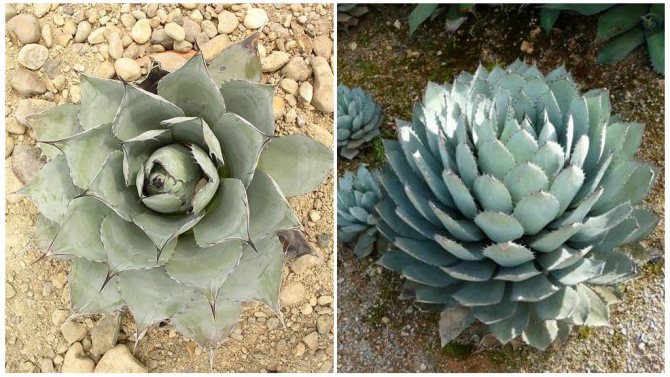

Agave parrasana Berger
Agave brown-yellow (Agave lurida Ait)
A plant with a highly shortened stem. Succulent leaves are collected in a rosette. Agave is about 180 cm in diameter, leaves 120 cm long, linear, flat, gray-green, have small light spines at the edges and end with a sharp thorn.
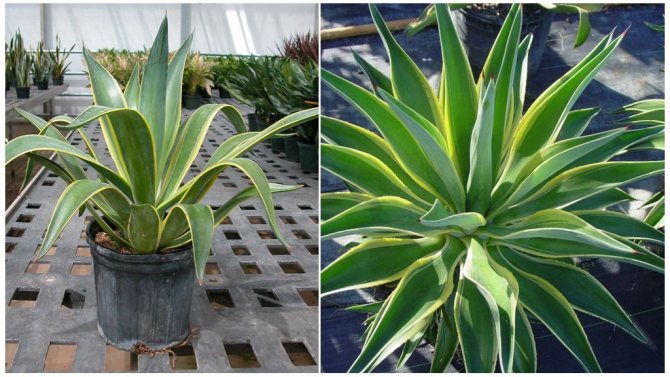

Agave brown-yellow (Agave lurida Ait)
Agave potatorum Zucc
Rosette of leaves 20-25 (rarely 55) cm in diameter. Leaves obovate, spatulate, 20-30 cm long, 9-11 cm wide, gray-green with a dark red or almost black thorn at the end. The edges of the leaf are notched with spines of the same color as at the end of the leaf. Homeland - Central America. This species has a very beautiful variety Fershaffelt (var. Verschaffeltii), which was collected and first brought to Russia by Baron Karvinsky, who lived in St. Petersburg.
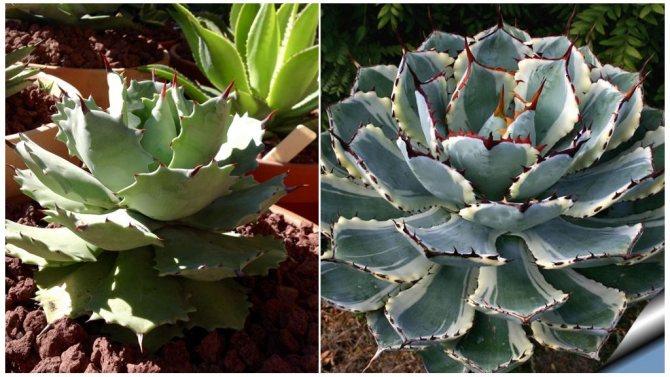

Agave potatorum Zucc
Agave terrible (Agave horrida Lem)
The rosette consists of a few inverse lanceolate hard leathery dark green leaves about 40 cm in length. Leaf margins with horn edging, notched-dentate, teeth 1-2 cm long, almost black, sharp, strong. Peduncle up to 4 m tall. Flowers up to 5 cm long, yellow-green.
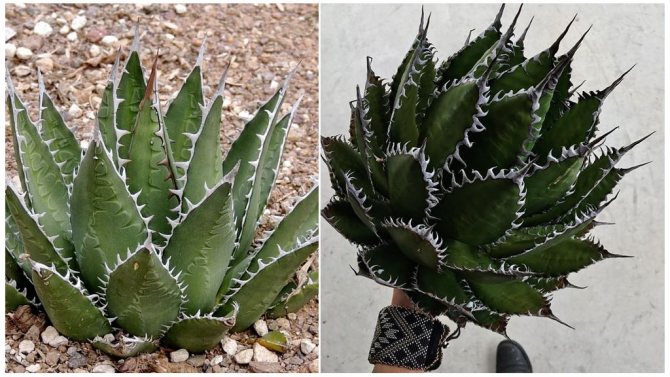

Agave terrible (Agave horrida Lem)
Agave funkiana C. Coch. Et Bouche
Stemless, perennial, evergreen rosette plant. Leaves are fleshy, narrow at the base, widening towards the middle, along the edges and at the end with brown thorns, gray-green-bluish. This relatively small, slow growing agave is suitable for growing in rooms with light windows. Very decorative. Propagated by offspring, which are separated in spring during transplantation and planted in small pots. Undemanding to the soil, grows on lean sandy and rocky lands. Loves a sunny outdoor location: balcony, terrace or open window. In winter, it is better to keep it cool and rarely water it.
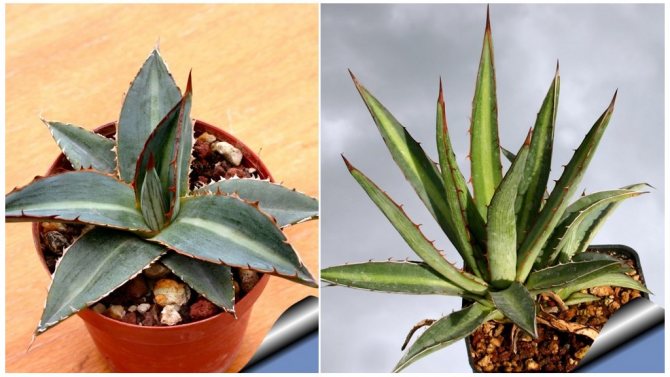

Agave funkiana C. Coch. Et Bouche
The plant requires almost no maintenance, except for the removal of inflorescences after flowering. In summer, the plant can be taken out into fresh air.
When keeping agave, it should be borne in mind that the plant does not like frequent watering. Also, the flower cannot be sprayed.
Agave is a very unusual plant. It will fit perfectly into any mini-garden. It can be planted on an alpine slide or when forming a stone garden. The plant does not require particular care and, subject to all the rules of maintenance, will grow beautiful and pleasing to the eye.
Photo
Below you will see a photo of a blue agave:
general description
Many dream to see how agave blooms. But agave blooms only in the sixth year, or even later.During this period, the plant throws out an unusual peduncle, the height of which sometimes reaches 12 m, it can contain up to 17 thousand yellow flowers. In most cases, the ground part of the agave dies off completely immediately after the fruit ripens.
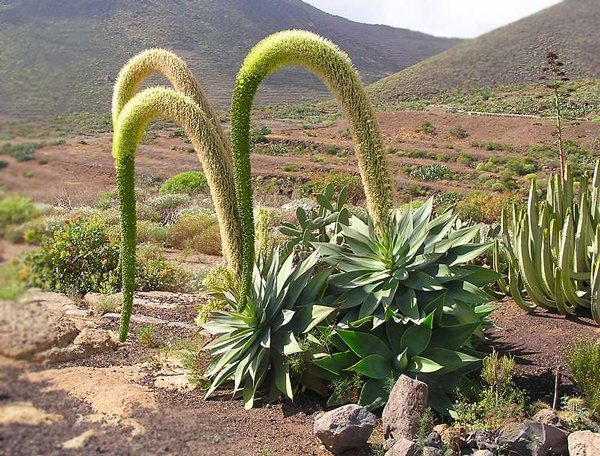

In the wild, the evergreen desert agave is found only in Mexico and Central America. However, due to its beauty and a number of medicinal properties, it was distributed by humans all over the world. It took root not only in the tropics or subtropics, but also in countries located much to the north, the cold climate of which meant that it could only be grown at home or in warm greenhouses.
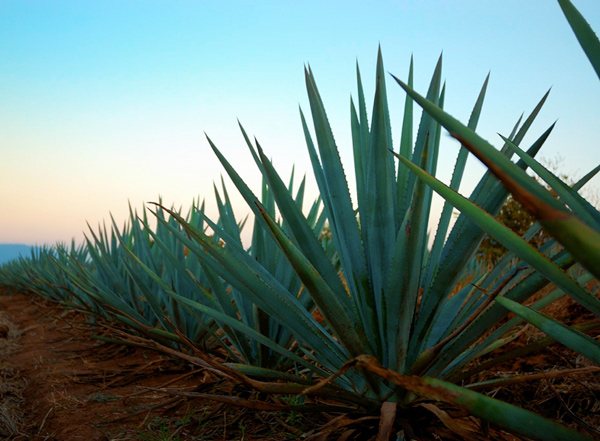

Europeans met this representative of the flora of the American continent around the middle of the 16th century. At least at this time, it is mentioned in the records of P. Martyr, dated 1533.
Currently in the Mediterranean countries it is customary to grow American agave as an ornamental plant for landscaping streets and squares... On the territory of Russia, it can be found in parks in the southern part of Crimea and on the Black Sea coast of the Caucasus.
In the last century, the Arizona agave was on the verge of extinction. There were no more than a hundred copies of it left. But soon everything returned to normal, the decline in the population was stopped.
Thread-bearing
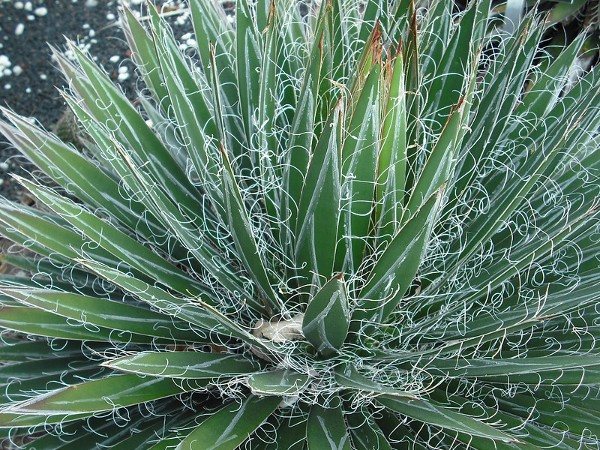

It got its name from the white threads that grow along the edges of the leaves. They themselves are thin, about 20 cm long, dull green in color, ending in brown or gray thorns. This species can also grow in homes with bright light and adequate watering. In winter, it tolerates temperatures from 4 to 10 C.
This is a fairly easy-to-care plant that does not require a lot of money and time. Should keep her on south side at home, in summer, move to fresh air. Requires a transplant in the spring and feeding 1-2 times a year.
In the summer you need to water moderately, in the winter you need to spray. Rarely sick, but easy to treat with the help of special fertilizers.
In many countries, this succulent is considered favorable for keeping in homes, since has a positive energy, and its healing and disinfecting properties of Agave are known to everyone.
Great for decorating gardens and parks. Such perennials will delight you with their appearance for a long time. Having considered the main types of Agave (Queen Victoria, Blue, American, Marginata, etc.) with a photo, you can choose the most suitable one for yourself.
Beneficial features
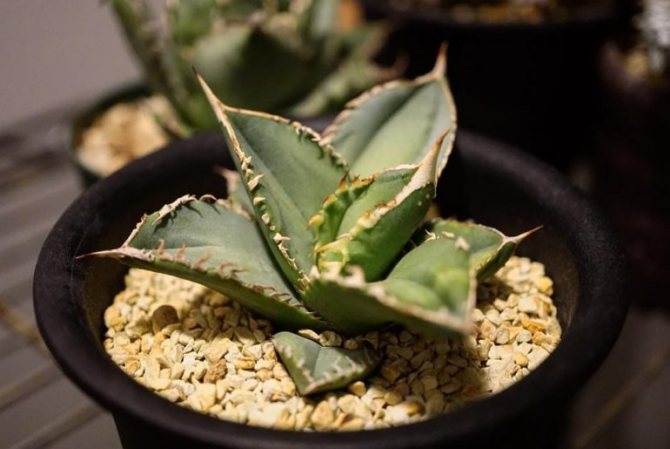

Photo of agave in a pot
It releases phytoncides, which have disinfecting properties and strengthen people's immunity, reduce the level of harmful microflora in the room, saturate the air with mineral and organic compounds, remove negative ions from the air, which makes it cleaner.
Under the influence of volatile components, the cleanliness of the air in the room approaches the forest level. In a room where plantations of agave are present, the number of harmful insects is usually sharply reduced.
What is obtained from the fruit?
Many types of agave are used in the industry for the production of coarse textile fibers, but blue agave has gained worldwide fame due to the fact that its juice is used as a raw material for the production of alcoholic beverages: mezcal, pulque and the famous tequila. Therefore, the additional name for blue agave is tequila.
How long does agave grow for tequila? Harvesting for the further production of tequila is carried out only in the 12th year of the plant's life. In production, the fruit of the agave is used, from which all leaves and roots are pre-cut; its weight reaches 70 kg. The fruit is cut into two or four pieces, depending on its size, and boiled, and fermented juice is processed into tequila... The smell of the juice is slightly tart and sweet, like that of tequila itself, and it tastes like honey. At the same time, the juice has a low glycemic index.
For a long time, the aborigines considered this plant useless.According to various legends, it was the gods who pointed out to people the beneficial properties of blue agave and taught them how to make delicious juice from it, from which, in ancient times, a low-alcohol drink pulque was made, which was used for ritual purposes.
And in the middle of the 18th century, the juice began to be distilled and turned into spirits. It was this drink that glorified the place called Tequila, which in the state of Jalisco, to the whole world, where the ritual of drinking was formed - with salt and a slice of lime. A bottle of tequila made from a blue agave plant must be 100% agave, and the inscription Hecho en Mexico says that inside it is a product of traditional unabridged production.
You can read about the medicinal properties of agave here.
Agave cultivation problems
Basically, agave is bothered by scale insects, they suck out cell juice from the leaves, the leaves wither, turn pale and fall off. The pest appears as brown plaques on the leaf surface or at the base of the stems. It is necessary to take household soap, foam it a little and wipe the bush with a soft sponge, then it is recommended to spray with a 0.15% solution of the Actellik (or Aktara) preparation at the rate of 1-2 ml per liter can of water. You should also fight the spider mite, due to which the leaves are deformed, turn yellow and fall off, and a thin cobweb may appear at the base of the stem. But usually the appearance of this pest is accompanied by increased dryness in the room.
If the leaves of a plant turn yellow, this means a lack of trace elements, dry soil in the summer or insufficient illumination, or increased air temperature, especially at night in the autumn-winter period.
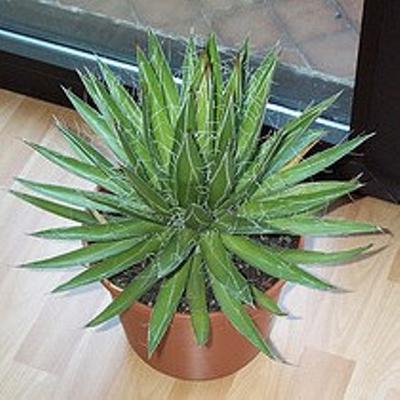

When only the top of the leaf of an agave turns yellow, this means that the earthy clod is overdried, or there is too much calcium in the substrate. If the turgor of the leaves has decreased, they hung down to the ground or began to crumble even green, then this indicates insufficient moisture or a mismatch in temperature indicators under conditions of detention, especially for winter days. Agave leaf plates have become wrinkled, which means that they were exposed to cold air, and this also indicates a lack of potassium, magnesium and phosphorus, especially in old leaves.
If the whole plant turns yellow, then there has been a strong overdrying of the substrate or its gulf, the humidity in the room has dropped, the soil is incorrectly selected and it is too heavy and dense for the agave, but perhaps the plant is preparing for a dormant period.
Where it grows in nature
When clematis blooms, what are pruning groups
Under natural conditions, agave grows in the mountains of Mexico with a hot climate, as well as in regions of North and Central America. Mostly found on rocky soil. Agave tolerates dry periods and high temperatures well. On the continent of Eurasia, the plant appeared after the discovery of America.
Additional Information. Currently, the plant grows on the shores of the Mediterranean Sea, in the Black Sea regions, in the Caucasus and Crimea.
Use for various diseases
American agave can be used as an adjuvant in the complex therapy of pathologies such as:
- bronchitis, pneumonia, ARVI, ARI;
- gastritis;
- gout, sciatica, arthritis;
- osteochondrosis, sciatic nerve neuralgia;
- acne, furunculosis;
- constipation;
- swelling.
Agave is suitable for the symptomatic treatment of toothache, cough, liver and stomach diseases. However, before using it, be sure to consult with a qualified doctor.
Watering
This unpretentious plant is American agave. Caring for it comes down to a rather rare watering and periodic feeding with nutrients.
Agave should not be watered very often. One, maximum twice a week will be enough for her. In winter, experienced flower growers recommend reducing watering to once a month. Water stagnant in the pot can cause root rot and plant death.Make sure that no moisture gets into the center of the outlet during watering.
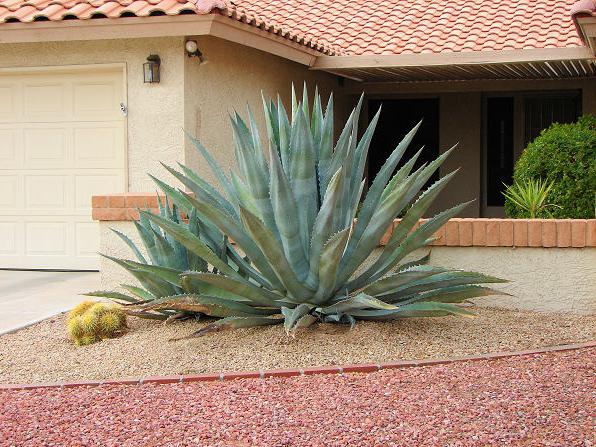

Gallery: American agave (25 photos)
Funka
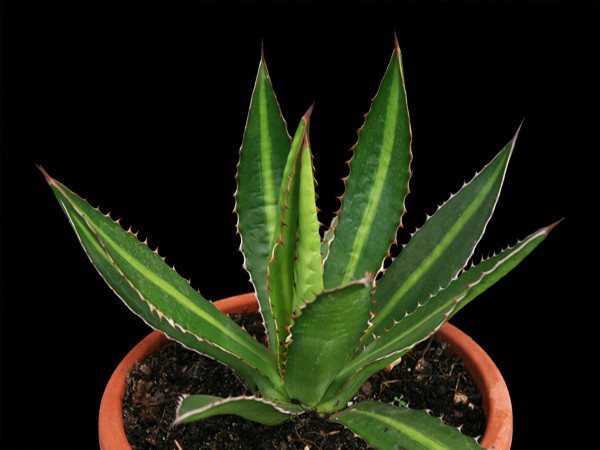

This species has no stem and growing slowly. And due to its attractive appearance, it is excellent for decorative breeding. The leaves are light green, very narrow at the base and gradually widen towards the middle. They are bordered with thorns along their perimeter.
In the spring it requires a transplant, and in the winter it is favorable to be in a cool room.
Parras
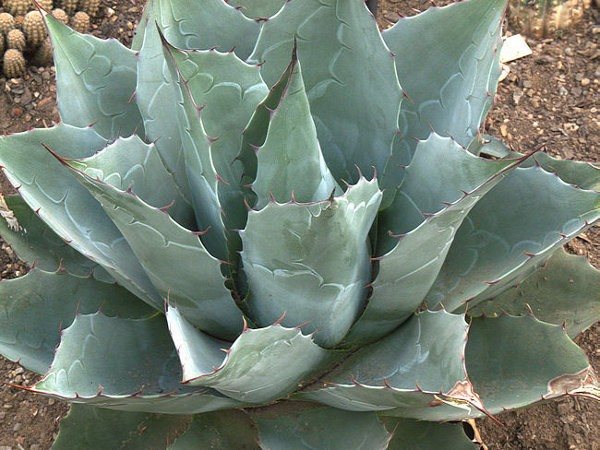

Non-flowering plant with large, dense light green leaves, the length of which is about 30 cm.At the edges of the leaves there are red, sometimes brownish spines up to 1 cm long. for home cultivation. It grows well at temperatures from 20 C in summer in the open air. In winter, the plant should be brought into a cool and dry room with a temperature of at least 10 C.
Application
Today, folk healers (as well as representatives of traditional medicine) are well known to agave. Description, application of its medicinal properties can be found in many phytotherapeutic and medical reference books.
Agave medicines have a laxative effect on the human body. The laxative effect usually occurs 10-12 hours after taking the drug. In addition, drugs based on agave have anti-inflammatory, bactericidal, antipyretic effects. Such agents disinfect, remove excess fluid from the body, accelerate metabolism, normalize the activity of the gastrointestinal tract and gallbladder. Cut agave leaves can be used as compresses for abscesses, wounds, and sciatica.
Does this plant have a relationship with a cactus?
Agave cactus or not? The thorns on the tips of the leaves can mislead some about the belonging of the agave to the cactus. In fact, these plants have only one similarity: they are both succulents, that is, they are able to accumulate water. This ability is present in most plants growing in hot and arid climates, regardless of genus and family. Most desert plants are very succulent for this reason. But nonetheless, agave is not included in the number of cacti and is not a tree.
The differences between agave and cactus and aloe are described in this article.

